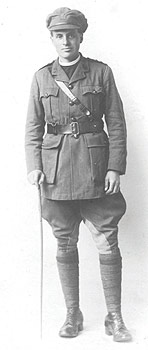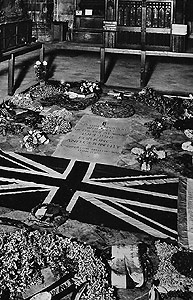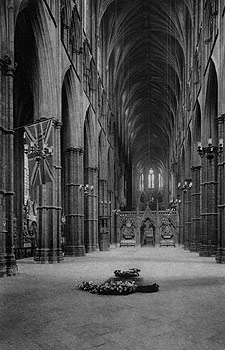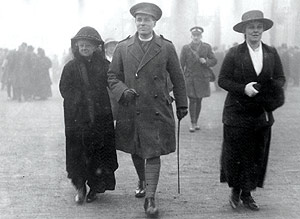|
THE FLAG
by Andrew Richards
formerly The Life Guards
|
Sometime around Remembrance Day 2013 I started reading all I could find about the Unknown Warrior. Although I wasn’t looking for a new writing project at the time, for some inexplicable reason, like a moth to a flame, I was drawn to this fascinating story. What tipped me over the edge, convincing me that I should write a book, was a short video I found on YouTube that appeared on the BBC’s The One Show. Narrated by Dan Snow, the short film not only described the burial of the Unknown Warrior in Westminster Abbey on Armistice Day 1920, but it told of the little-known involvement of a remarkable man. Four years later, I had the honour of speaking in front of friends and family at the launch of the book, The Flag, at the Household Cavalry Museum. For me, from genesis to completion, writing the book was a journey of discovery; one where I learnt the true of meaning of service and sacrifice.

Chaplain to the Forces Class 4 (Captain) Revd David Railton. Photograph taken before November 1916, when he was awarded the Military Cross. Railton Family Archives
|
The Reverend David Railton MC not only heard the clarion call of his country during times of war, but throughout his life he dedicated himself to his fellow man. Whether it was sheltering the homeless and needy, comforting the sick, or consoling grieving widows and their children, he sacrificed much so that he could help others. In a time of bitter sectarian division, he preached tolerance and understanding. And despite class divisions of the time he worked hard to maintain the comradeship of the trenches. Despite suffering the effects of gas, and what we now know to be post-traumatic stress disorder, he tried to raise awareness for ex-servicemen. On at least one occasion he disguised himself as a tramp for a week, living off only what he could earn, sleeping rough, and in doss houses, reporting their terrible plight to the press afterwards.
A brilliant orator, he used his voice to not only rebuild the faith of his own parishioners from the pulpit, but he was willing to go to the people wherever they were. At work in the factories and mills, at home, whether they lived in Victorian tenement housing or a mansion, in the public houses of the industrial north, or in their gardens and allotments, helping them with everyday chores. He was a man of all people.
Much has been written about the burial of the Unknown Warrior and all the different controversies regarding whose idea it was, whose flag was used, even details like how many bodies were selected from battlefields on the Western Front. One of the reasons that David Railton’s name was virtually unknown until the 1930s was because he was unwilling to accept praise or have his name mentioned above those that he cared so much about.
During my research, one of the most difficult things I had to do was to try and break through the silence that surrounded so much of his achievements; little was known about him. Luckily for me, he was a serial note-taker. Despite not wanting to talk about his time on the Western Front, he kept many artefacts; he scribbled notes recording his thoughts on almost everything, photographs, letters, poetry, copies of routine and standing orders, a copy of a wedding certificate, and even a German propaganda leaflet. He didn’t want his name in the spotlight, and I’m sure if he was still with us now he’d be mildly irritated at some of the things I have written about him. But I know for sure he would have wanted me to tell the stories of the men he’d served with, and of the men he had buried, covered by his flag.
Sometimes I became stuck in my research, unable to piece something together, a primary source leading me away from the official history of an event, or a date and time that didn’t match another record or account of events. Despite this, I always found something, particularly amongst his notes in the Railton archives which allowed me to connect the dots. At times, it felt like he was standing above me pointing the way forward, urging me to get the facts straight. I felt sure he wanted me to tell of the 47th Division, the men that endured the aftermath of High Wood, of the Reverend J J Wallace who was killed just before the Armistice was signed, or Private Blakemore, who was executed for desertion, and of the real story behind the Unknown Warrior, and his flag.

Because of the sheer numbers of people wanting to pay their respects, the grave of the Unknown Warrior was not sealed until 18th November, 1920. A slab of York stone was placed over it, and David’s flag was laid at the foot of the grave for the next 12 months. Image by Wildt and Kray, London
|

The Padre’s Flag was dedicated and hung above the grave of the Unknown Warrior on Armistice Day 1921. It remained there until 1953, when it was moved to St George’s Chapel prior to the Coronation of Queen Elizabeth II
Photo by Walter Scott
|
 The Railtons making their way towards Westminster Abbey. The gates of Buckingham Palace can be seen through the fog. Railton Family Archives The Railtons making their way towards Westminster Abbey. The gates of Buckingham Palace can be seen through the fog. Railton Family Archives
|
Three years ago, during a visit to Westminster Abbey whilst I stood at the foot of the grave of the Unknown Warrior, it occurred to me that the relationship and connection between this soldier lying in Westminster Abbey and David Railton’s flag is the same today as it was almost a century ago. At first, I was a little annoyed to discover that in 1953 the flag was moved from above the grave, where it had been since Armistice Day 1921. I had to ask where it was; tucked away behind a pillar in St George’s Chapel, just another tattered, old, ordinary flag, nothing special to look at really. But having spent many, many hours writing about this most amazing man, I honestly believe it is what he would have wanted. His flag, his altar-cloth, his life, tinged with the blood of a generation, hangs just a few feet from his great vision. For those who want to look, it’s there, unobtrusive, a plain and simple flag, unknown, but always, very much part of our nation’s history.
|
|




 The Railtons making their way towards Westminster Abbey. The gates of Buckingham Palace can be seen through the fog. Railton Family Archives
The Railtons making their way towards Westminster Abbey. The gates of Buckingham Palace can be seen through the fog. Railton Family Archives